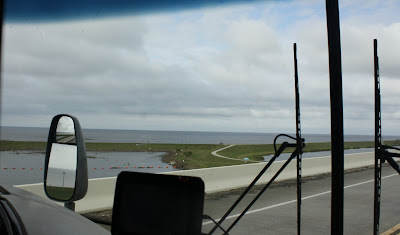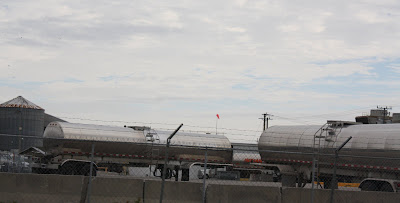 We have arrived at our Orlando home. It is almost full we had the choice of maybe 10 spaces. When we left Fort Lauderdale it was 8ish, 78 degrees, and 97% humidity. Here at 3ish it was 60 degrees and 100% humidity. We do welcome the cooler temperatures. We do not hear a train or the highway noises.
We have arrived at our Orlando home. It is almost full we had the choice of maybe 10 spaces. When we left Fort Lauderdale it was 8ish, 78 degrees, and 97% humidity. Here at 3ish it was 60 degrees and 100% humidity. We do welcome the cooler temperatures. We do not hear a train or the highway noises.  So my story is what we saw from the road on our trip. Rog does try to take different ways when we travel so we do get to see different things. Here you are looking at sugar cane.
So my story is what we saw from the road on our trip. Rog does try to take different ways when we travel so we do get to see different things. Here you are looking at sugar cane. 
Growing Sugar Cane
Sugar cane grows exceptionally well in the deep muck soils of Florida's Everglade Agricultural Area (EAA), south of Lake Okeechobee. Ample rainfall and tropical temperatures during summer months create ideal growing conditions, and the moderate winters are perfect for harvesting.Planting takes place from September through January. Cane seeds, produced in white or reddish plumes at the tops of mature cane stalks are too small to be planted directly in the field. Instead, stalks are harvested from mature fields and cut into short 20-inch segments then placed in furrows and covered with soil. Sprouts from the cane stalks emerge two to three weeks later.
After 10-12 months, the sugar cane is ready for harvest. All of Florida Crystals' fields are mechanically harvested, using combine-like machines that slice the cane stalks just above root level. The cut cane is then transferred to trailers and taken to the mill for processing.
Sugar cane is typically grown for three years, then the fields are rotated with rice. Rotating sugar cane with rice restores the soils fertility, kills unfriendly burrowing nematodes and provides a rich habitat for many species of wading birds. Sugarcane is the world's largest crop. In 2010,it was estimated it was cultivated on about 23.8 million hectares, in more than 90 countries, with a worldwide harvest of 1.69 billion tons. Brazil was the largest producer of sugar cane in the world. Cane accounts for 80% of sugar produced; most of the rest is made from sugar beets.
 Trucks they haul sugar cane to the processing plant.
Trucks they haul sugar cane to the processing plant. This is the processing mill for sugar cane. Not sure what goes on inside and not sure I would want to hang around and find out because the stench is unbelievably foul and strong.
This is the processing mill for sugar cane. Not sure what goes on inside and not sure I would want to hang around and find out because the stench is unbelievably foul and strong. 
Lake Okeechobee is the largest lake in Florida and the second largest freshwater lake in the United States. Its name means "big water" in the Seminole Indian language. Its waters and nearby wetlands provide habitat for many animals, including the federally endangered Snail kite and a variety of wading birds. Migratory birds use the lake as a resting place.
The lake replenishes water storage areas, helps to irrigate agricultural lands, provides backup water for urban areas, and plays a major role in supplying water for the Everglades.
The 730 square-mile lake, with an average depth of ten feet, is famous for its fishing and is often referred to as the "Bass Capital of the World."
 Lake Okeechobee sits in a shallow geological trough that also underlies the Kissimmee River Valley and the Everglades.
The trough is underlain by clay deposits that compacted more than the
limestone and sand deposits did along both coasts of peninsular Florida.
The name Okeechobee comes from the Hitchiti words oki (water) and chubi (big).
Lake Okeechobee sits in a shallow geological trough that also underlies the Kissimmee River Valley and the Everglades.
The trough is underlain by clay deposits that compacted more than the
limestone and sand deposits did along both coasts of peninsular Florida.
The name Okeechobee comes from the Hitchiti words oki (water) and chubi (big).  We could not see the lake because there is a big dike built around it because of the many hurricans that caused tremendous storm surges that caused much damage and killed many people
We could not see the lake because there is a big dike built around it because of the many hurricans that caused tremendous storm surges that caused much damage and killed many people



No comments:
Post a Comment